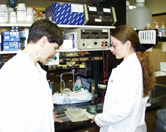UNMC researchers have received a four-year, $1.7 million grant from the U.S. Department of Defense to develop an efficient way to protect humans against the toxic effects of nerve agents used in chemical warfare. Nerve agents are chemicals related to the organophosphorus group of pesticides, which interfere with the functioning of the nervous system.
 “The goal of the study is to find a way to treat people who have been exposed to chemical warfare nerve agents, which can be fatal or cause extensive health damage,” said Oksana Lockridge, Ph.D., principal investigator of the grant. “The Army is very interested in getting a protection against chemical warfare agents, because the agents are so easy to make.
“The goal of the study is to find a way to treat people who have been exposed to chemical warfare nerve agents, which can be fatal or cause extensive health damage,” said Oksana Lockridge, Ph.D., principal investigator of the grant. “The Army is very interested in getting a protection against chemical warfare agents, because the agents are so easy to make.
Dr. Lockridge is an associate professor in the UNMC Eppley Institute for Research in Cancer and Allied Diseases and in the department of biochemistry and molecular biology.
The study will use gene and protein therapy — the treatment of disease by replacing, altering or supplementing a gene or protein responsible for the disease — to better protect against effects of nerve agents. A technique being tested through Dr. Lockridge’s research is administration of a protein applied through a skin patch.
“We know the identity of a human enzyme, butyrylcholinesterase, that will neutralize any pesticide or chemical warfare agent very effectively without being toxic to a person or an animal,” Dr. Lockridge said. “With this protection, you won’t even know you got hit with something.”
Butyrylcholinesterase is found in blood, the liver and other tissues; however, its function is not specifically known.
Breathing 10 milligrams — the weight of a grain of rice — of the deadliest nerve agent, called VX, can kill in 15 minutes. Symptoms of nerve agent exposure include reduced vision, diarrhea, vomiting, paralysis and respiratory failure. Ultimately, individuals experience convulsions and go into a coma. An antidote kit called the Mark I, distributed to U.S. troops during the Gulf War, is currently available for protection against death by nerve agent exposure. Dr. Lockridge’s study is looking for a better alternative.
Chemical warfare was used in the 1995 Toyko subway terrorist attacks, when members of a cult placed sarin gas on the trains, killing 12 and injuring more than 5,500. Agents such as sarin, VX and tabun are inexpensive and easy to manufacture and have been used as weapons of terrorism and defense mechanisms for Third World countries.
“A method must be developed that shields humans from the effects of chemical warfare agents and provides medical treatment for those who become exposed,” Dr. Lockridge said.
Her study also is relevant to Nebraska farmers because of the similarity in makeup of chemical warfare agents and pesticides. About 80,000 cases of pesticide poisoning are reported annually in the United States. Common pesticides such as roach and ant killers are in the same class of chemicals as the chemical nerve agents.
With the system of gene and protein therapy currently developed in Dr. Lockridge’s lab, the cost of protecting one person is at least $1 million. Researchers are looking for ways to lower the cost so it would be a realistic option to protect the general public.
Co-investigators of the study are Steven Hinrichs, M.D., associate professor of pathology and microbiology and director of the Nebraska Public Health Laboratory, and Angie Rizzino, Ph.D., professor in the Eppley Institute and department of biochemistry and molecular biology.
Photo cutline: Oksana Lockridge, Ph.D., and Anna Hrabovska, Pharm.D., a post doctoral research fellow, work with DNA in their study to develop an efficient way to protect humans against the toxic effects of nerve agents used in chemical warfare.